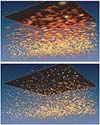 |
Tokyo (AFP) May 25, 2007 Japanese high-tech giants Canon and Toshiba said Friday they had decided to postpone indefinitely the launch of a new type of flat television panel which is mired in legal wrangling. SED television sets were due to be introduced in Japan in the fourth quarter of 2007. No new launch date was given. "Reasons for the postponement include prolonged litigation currently underway in the United States and efforts to establish mass-production technology aimed at realising further cost reductions," a Canon statement said. The delay forced Toshiba to put off the sales launch of the surface-conduction electron-emitter display (SED) TVs as it had planned to source the screens from Canon. Austin, Texas-based Nano-Proprietary Inc. sued Canon for allegedly breaking its 1999 patent license agreement for key technology in the production of SED sets. The US firm argued that the agreement does not allow Toshiba access to its intellectual property so the venture cannot be transferred the license rights. Canon, which began research on SED in 1986, announced in January that it had agreed to buy Toshiba's 50 percent stake in their joint venture making SED TV panels in hopes of resolving the dispute. The technology, which uses electrons with a phosphor-coated screen, offers high efficiency for low power consumption, according to the high-tech giant. Canon is also developing organic electro-luminescence display screens, as is rival Sony Corp. which aims to launch televisions using the technology later this year.
Source: Agence France-Presse Related Links Canon Toshiba Space Technology News - Applications and Research
 Champaign IL (SPX) Feb 07, 2007
Champaign IL (SPX) Feb 07, 2007Researchers at the University of Illinois at Urbana-Champaign have developed a novel computational image-forming technique for optical microscopy that can produce crisp, three-dimensional images from blurry, out-of-focus data. Called Interferometric Synthetic Aperture Microscopy, ISAM can do for optical microscopy what magnetic resonance imaging did for nuclear magnetic resonance, and what computed tomography did for X-ray imaging, the scientists say. |
|
| The content herein, unless otherwise known to be public domain, are Copyright Space.TV Corporation. AFP and UPI Wire Stories are copyright Agence France-Presse and United Press International. ESA Portal Reports are copyright European Space Agency. All NASA sourced material is public domain. Additional copyrights may apply in whole or part to other bona fide parties. Advertising does not imply endorsement, agreement or approval of any opinions, statements or information provided by Space.TV Corp on any Web page published or hosted by Space.TV Corp. Privacy Statement |